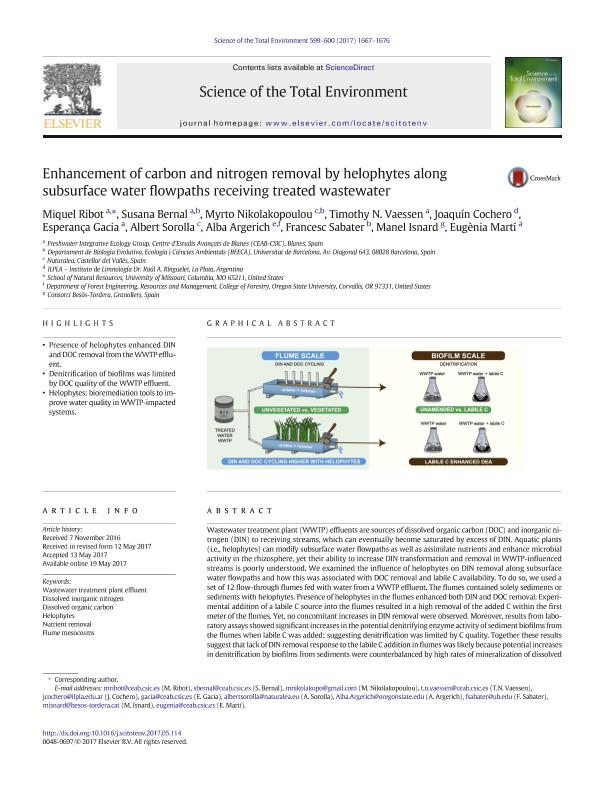Artículo
Enhancement of carbon and nitrogen removal by helophytes along subsurface water flowpaths receiving treated wastewater
Ribot, Miquel; Bernal, Susana Margarita; Nikolakopoulou, Myrto; Vaessen, Timothy; Cochero, Joaquin ; Gacia, Esperança; Sorolla, Albert; Argerich, Alba; Sabater, Francesc; Isnard, Manel; Martí, Eugènia
; Gacia, Esperança; Sorolla, Albert; Argerich, Alba; Sabater, Francesc; Isnard, Manel; Martí, Eugènia
 ; Gacia, Esperança; Sorolla, Albert; Argerich, Alba; Sabater, Francesc; Isnard, Manel; Martí, Eugènia
; Gacia, Esperança; Sorolla, Albert; Argerich, Alba; Sabater, Francesc; Isnard, Manel; Martí, Eugènia
Fecha de publicación:
05/2017
Editorial:
Elsevier Science
Revista:
Science of the Total Environment
ISSN:
0048-9697
Idioma:
Inglés
Tipo de recurso:
Artículo publicado
Clasificación temática:
Resumen
Wastewater treatment plant (WWTP) effluents are sources of dissolved organic carbon (DOC) and inorganic nitrogen (DIN) to receiving streams, which can eventually become saturated by excess of DIN. Aquatic plants (i.e., helophytes) can modify subsurface water flowpaths as well as assimilate nutrients and enhance microbial activity in the rhizosphere, yet their ability to increase DIN transformation and removal in WWTP-influenced streams is poorly understood. We examined the influence of helophytes on DIN removal along subsurface water flowpaths and how this was associated with DOC removal and labile C availability. To do so, we used a set of 12 flow-through flumes fed with water from a WWTP effluent. The flumes contained solely sediments or sediments with helophytes. Presence of helophytes in the flumes enhanced both DIN and DOC removal. Experimental addition of a labile C source into the flumes resulted in a high removal of the added C within the first meter of the flumes. Yet, no concomitant increases in DIN removal were observed. Moreover, results from laboratory assays showed significant increases in the potential denitrifying enzyme activity of sediment biofilms from the flumes when labile C was added; suggesting denitrification was limited by C quality. Together these results suggest that lack of DIN removal response to the labile C addition in flumes was likely because potential increases in denitrification by biofilms from sediments were counterbalanced by high rates of mineralization of dissolved organic matter. Our results highlight that helophytes can enhance DIN removal in streams receiving inputs from WWTP effluents; and thus, they can become a relevant bioremediation tool in WWTP-influenced streams. However, results also suggest that the quality of DOC from the WWTP effluent can influence the N removal capacity of these systems.
Archivos asociados
Licencia
Identificadores
Colecciones
Articulos(ILPLA)
Articulos de INST.DE LIMNOLOGIA "DR. RAUL A. RINGUELET"
Articulos de INST.DE LIMNOLOGIA "DR. RAUL A. RINGUELET"
Citación
Ribot, Miquel; Bernal, Susana Margarita; Nikolakopoulou, Myrto; Vaessen, Timothy; Cochero, Joaquin; et al.; Enhancement of carbon and nitrogen removal by helophytes along subsurface water flowpaths receiving treated wastewater; Elsevier Science; Science of the Total Environment; 599-600; 5-2017; 1667-1676
Compartir
Altmétricas



